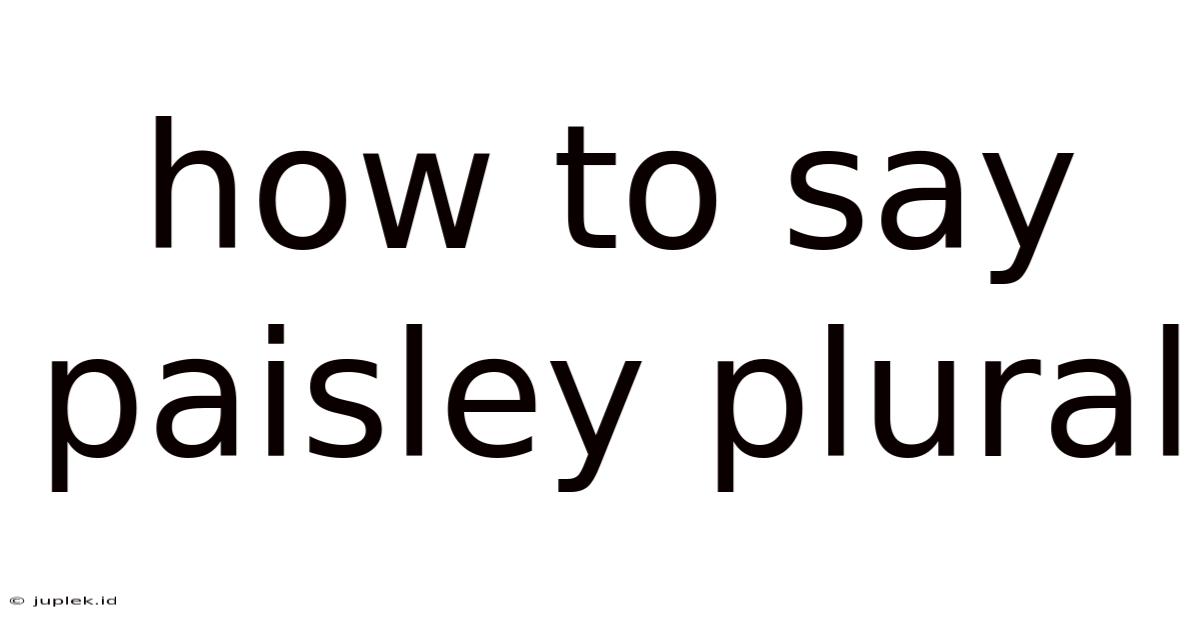How To Say Paisley Plural

Discover more detailed and exciting information on our website. Click the link below to start your adventure: Visit Best Website meltwatermedia.ca. Don't miss out!
Table of Contents
How to Say Paisley Plural: A Deep Dive into a Pattern's Linguistic Quirks
The paisley pattern, with its swirling, teardrop-like motifs, is instantly recognizable. But what about the plural of paisley? This seemingly simple question opens a surprisingly complex discussion touching on linguistics, pattern recognition, and even the history of the design itself. There isn't a single definitive answer, and the "correct" usage depends heavily on context and personal preference. Let's unravel this linguistic puzzle.
The Problem with "Paisleys": A Grammatical Quandary
The most intuitive approach, mirroring the pluralization of most English nouns, is to add an "s" – "paisleys." However, this straightforward solution isn't universally accepted. The word "paisley" is unusual. It's not inherently a word describing a single, countable object like "chair" or "apple." It denotes a pattern, a design, a style. And patterns, by their nature, are continuous and potentially limitless in their application. This inherent ambiguity makes pluralization tricky.
Consider this: you wouldn't say "I saw several reds" to describe multiple red objects; you'd use a descriptive phrase like "I saw several red items" or "several red things". Similarly, saying "I have several paisleys" feels slightly off. The word "paisleys" implies individual, discrete paisley motifs, which isn't always the case. A garment might incorporate the paisley pattern without having clearly defined, separable paisley motifs.
Alternative Approaches: Nuance in Language
Given the ambiguity, alternative phrasing is often preferred for clarity and accuracy:
-
Using descriptive phrases: Instead of relying solely on "paisleys," one can use phrases like "paisley patterns," "paisley designs," "paisley prints," or "items with paisley patterns." This approach avoids the grammatical ambiguity entirely. For instance: "The collection showcased a variety of vibrant paisley patterns." This is clear, precise, and grammatically correct.
-
Focusing on the objects: If the paisley pattern is applied to specific objects, the plural form focuses on the objects themselves. "I have several paisley scarves," "The store displayed numerous paisley dresses," or "He collected many paisley shawls" are all perfectly acceptable and unambiguous. Here, "paisley" acts as an adjective describing the objects, avoiding the direct pluralization issue.
-
Using "paisley-printed" or similar adjectives: Another effective method is to use the word "paisley" as an adjective, creating a compound adjective. For example, "Several paisley-printed fabrics were available" or "The room featured several paisley-colored cushions." This elegantly side-steps the pluralization problem.
The Historical Context: Understanding the Word's Origins
Understanding the historical context of the word "paisley" can further illuminate the challenges of pluralization. The pattern's name derives from the Scottish town of Paisley, famous for its textile production. The term originally referred to the type of fabric, not individual motifs within the fabric. Thus, using "paisleys" to refer to multiple instances of the pattern on a single item feels jarring, while using it to describe multiple items featuring the pattern is more natural.
The Role of Context: Making the Right Choice
The "correct" way to pluralize "paisley" depends entirely on context. In a casual conversation, "paisleys" might be acceptable, particularly when referring to distinct paisley motifs. However, in formal writing or precise discussions of design, the descriptive phrases or adjectival approaches are generally preferred for their clarity and grammatical accuracy.
Analyzing Different Contexts: Examples
Let's illustrate the different approaches with concrete examples:
-
Incorrect/Ambiguous: "The dress featured numerous paisleys." (Implies separate paisley motifs, which isn't necessarily true.)
-
Correct/Clear: "The dress featured a beautiful paisley print." (Clearly refers to the overall pattern.)
-
Incorrect/Ambiguous: "I bought several paisleys at the market." (Unclear – paisleys what? Fabrics? Scarves? Items?)
-
Correct/Clear: "I bought several paisley shawls at the market." (Clearly defined objects.)
-
Correct/Clear: "The designer showcased a stunning collection of paisley-inspired garments." (Uses "paisley" as an adjective.)
-
Correct/Clear: "Many items with paisley patterns were displayed." (Descriptive phrase avoids the ambiguity.)
Beyond the Grammatical: A Deeper Look at Design
The difficulty in pluralizing "paisley" highlights a deeper linguistic issue: how we categorize and describe visual patterns. Words often struggle to fully capture the nuances of visual art and design. The paisley pattern itself is not a singular, easily countable object. It's a continuous flow of shapes, a stylistic expression, rather than a collection of discrete elements. This inherent complexity of the pattern itself contributes to the linguistic difficulties around its pluralization.
Conclusion: Embrace the Nuance
There's no single "right" answer to the question of how to say "paisley" plural. The most effective approach depends on the context and the desired level of precision. By understanding the inherent ambiguity of the word and adopting alternative phrasing when necessary, one can communicate clearly and accurately about this iconic and ever-evolving design. The key is to choose the phrasing that best reflects the specific meaning and avoids any potential confusion. Embrace the nuanced language needed to describe the richness and complexity of the paisley pattern itself. Ultimately, clear communication trumps strict adherence to a potentially problematic pluralization. Choose the option that best serves your clarity and purpose.

Thank you for visiting our website wich cover about How To Say Paisley Plural. We hope the information provided has been useful to you. Feel free to contact us if you have any questions or need further assistance. See you next time and dont miss to bookmark.
Also read the following articles
| Article Title | Date |
|---|---|
| How To Say Birthday In Irish | Apr 08, 2025 |
| How To Say Canadian In French | Apr 08, 2025 |
| How To Say Chair In Hindi | Apr 08, 2025 |
| How To Say Diploma In English | Apr 08, 2025 |
| How To Say Tornillo | Apr 08, 2025 |
